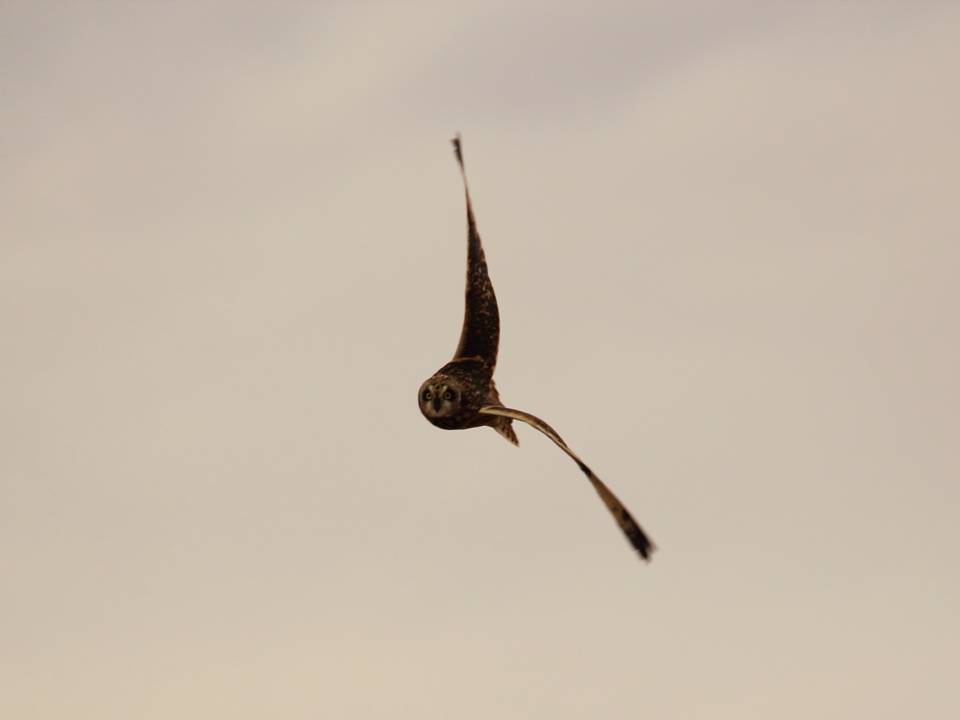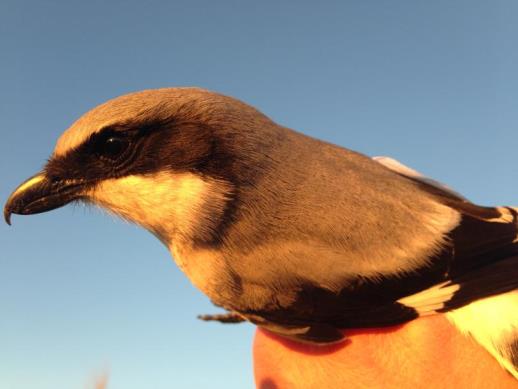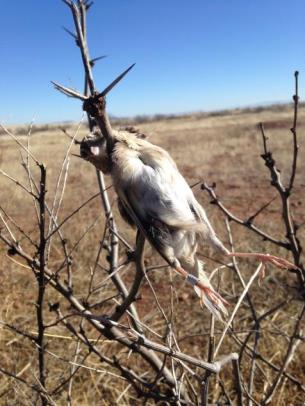It is Rocky Mountain Bird Observatory’s third winter studying survival and movement patterns of Baird’s and Grasshopper Sparrows on their wintering grounds in the Chihuahuan Desert grasslands. These diminutive birds spend the winter scurrying among clumps of brittle grasses seeking seeds and cover, all the while avoiding the ever-abundant predators that prowl the prairies, such as Northern Harriers, American Kestrels, Short-eared Owls and shrikes.
This season, winter 2014-15, with the aid of collaborators from Universidad Juárez del Estado de Durango and Universidad Autónoma de Nuevo León, we have expanded this research to include three field sites across northern Mexico. The principal site, monitored since winter 2012-13, is within the Reserva Ecológica El Uno near Janos, Chihuahua. In winter 2013-14, we added a field site at Rancho Santa Teresa in the Cuchillas de la Zarca Grassland Priority Conservation Area (GPCA) in northern Durango. This winter, we began monitoring in the Valle Columbia GPCA in Coahuila.
As of late February, across all three field sites this winter, we had captured, outfitted with transmitters and tracked 107 Baird’s Sparrows and 117 Grasshopper Sparrows using radio-telemetry. Baird’s Sparrows were absent last season at the Chihuahua site, but this species returned in good numbers this winter. We even had our first recovered Baird’s Sparrow, initially banded two winters ago! In addition to these sparrows, we had the unexpected fortune of capturing and radio-marking two Sprague’s Pipits on their wintering grounds. This species could be listed under the Endangered Species Act, and little information exists on its habits on the wintering grounds. Although one pipit became the victim of a Loggerhead Shrike, we are still tracking a pipit and gathering data on its habitat use and survival in Chihuahua.
We’ve had several special visitors to the Chihuahua field site. Film crews from PBS’ Windows to the Wild series, and the Prince William Network and U.S. Forest Service International Programs’ FSNatureLIVE distance learning adventure series, visited to capture our work on the ground. An especially esteemed visitor, The Consul General of the U.S. to Mexico, spent an afternoon and evening with the RMBO team. We hope our visitors help promote awareness of the plight of grassland birds to a broader audience.

Our three study sites span the Chihuahuan Desert and are within the Mexican states of Chihuahua, Durango and Coahuila.

The Short-eared Owl, one of the many declining species of grassland birds, also spends its winter in the Chihuahuan Desert where it feeds on small mammals – and the occasional sparrow. Photo by José Hugo Martínez Guerrero.

The team sets up a line of mist nets to capture sparrows flushed from the grasses. Photo by Greg Levandoski.

This sparrow was outfitted with a small 0.5-gram radio transmitter and will be tracked daily to determine what is impacting grassland bird survival and movement patterns. Photo by José Hugo Martínez Guerrero.
A technician scans with an antenna for missing birds in Chihuahua. We’ve found that a proportion of sparrows wander widely over the study area while others stick to their territory. This means hours of searching for lost birds. What could explain why some birds move and some stay put? Photo by Erin Strasser.

Take one look at that sharp beak and you’ll understand why Loggerhead Shrikes are adept at hunting sparrows. The majority of mortality has been attributed to these predators. We captured this individual using a specially designed shrike trap. In the future, we’d like to simultaneously track shrikes and sparrows to see how predators influence prey movements. Photo by Erin Strasser.

This Grasshopper Sparrow was killed and cached by a Loggerhead Shrike. Shrikes store their prey items on mesquite spines and barbed wire fences for later consumption. Photo by Erin Strasser.

Technicians take measurements on a Grasshopper Sparrow that will be outfitted with a transmitter and tracked this winter. Photo by Greg Levandoski.

Every once in a while, we capture something new and interesting in the mist nets. This is a Crissal Thrasher, a skulking bird that lives in mesquite habitat. Photo by Erin Strasser.

A film crew from New Hampshire Public Television interviews RMBO International Director Arvind Panjabi for an upcoming episode of its Windows to the Wild series. Photo by Greg Levandoski.
There are only a few more weeks left in the field season to track birds and collect information on their grassland habitat. Soon, we’ll recapture birds to lighten their load … that is, remove their transmitters for the last time. The unrelenting desert winds have picked up, and flocks of Snow Geese and Tree Swallows are passing through on their way north and will be followed shortly by the sparrows and pipits we’ve tracked since December.
Thank you to Universidad Juárez del Estado de Durango, Universidad Autónoma de Nuevo Leon and The Nature Conservancy for partnering on this research, and the Canadian Wildlife Service, USFWS Neotropical Migratory Bird Conservation Act, USDA Forest Service International Program and WWF-Carlos Slim Foundation for funding.
As with the last two field seasons, this winter has been insightful and fascinating. Stay tuned for an end-of-season update!
~ Erin Strasser, Biologist


